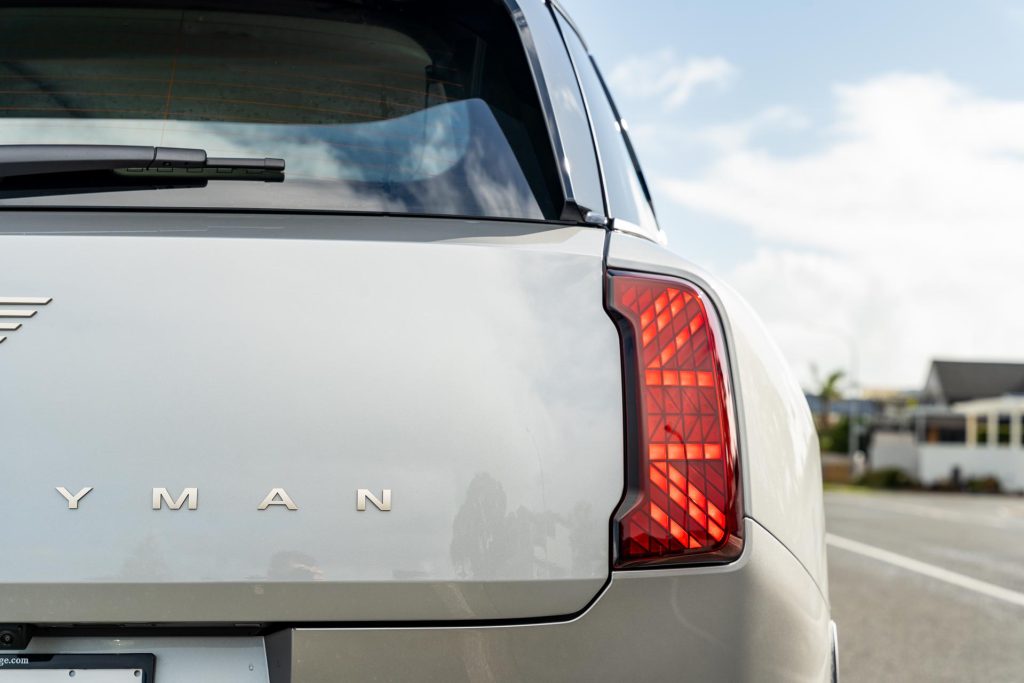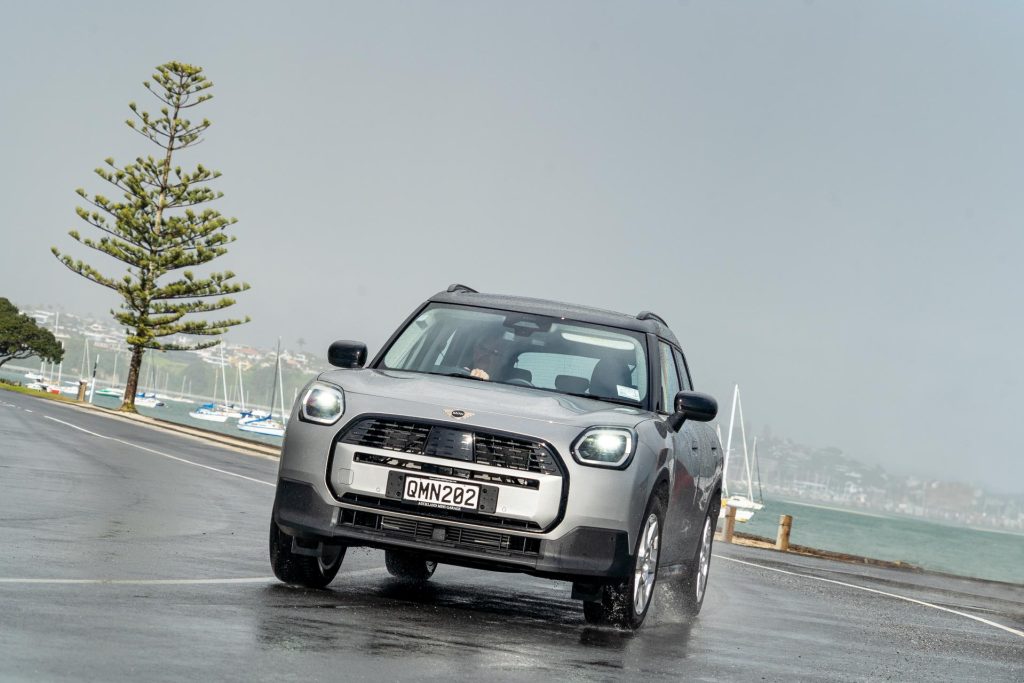2024 Mini Countryman Core Classic review
Words: Peter Louisson | Photos: Isaac Western
Mini has always dared to be different and that continues with the latest Countryman, now with a mild hybrid powertrain.
Countryman is back, renewed, not so as it’s immediately noticeable. But there are subtle changes as part of its ‘Charismatic Simplicity’ design language.
If anything they’re more noteworthy inside the vehicle which is 130mm longer than before and 60mm taller so it’s visibly roomier, especially in the rear seat area.

There’s a new OLED centre screen, still circular, as you’d expect for this is a traditional Mini point of difference.
The third-generation also features new tech and some will be excited to hear that it is also available as an all-electric Countryman E.
And of course there’s a JCW All4 variant (review next month), along with an SE electric All4 and an S All4 with a 2.0-litre engine.

But it’s none of those that you’re looking at here for this is the base Countryman C for Core model, kind of. It kicks off the range at $54,990 and we think is pretty decent, all in all.
The ‘kind of’ comment relates to the fact that there are three spec levels for the Core, this being the intermediate one (Classic) that adds Adaptive to Cruise Control, Sun to Roof and heating to seats for an extra $3k.
Want more? For another $4k you can have the Favoured model that also comes with powered sports seats by JCW and a premium Harmon Kardon 12-speaker sound system.

We reckon this here Classic is probably the sweet spot of the trio though.
Too many fake drive modes
Naturally, being part of the BMW group, there are plenty of tech features it borrows from vehicles like the 1 Series with which it shares a platform. And on the whole, therefore, that’s a good thing, a nice fit.
We’re still not convinced about the Experience modes which consist of three actual drive modes and five other ‘mood’ altering things. Core, Green, and Go-Kart are essentially Normal, Eco and Sport.

The rest are hokum, with lighting, soundscape and design aspects. Trail mode? In a FWD vehicle? Yeah nah.
At least the three actual drive modes do something; in Green it saves gas at the expense of reduced output, whereas in Go-Kart it actually adds zest along with a ‘wahoo’ outburst to signify such.
We tired of that all too quickly. Yes, I know, ‘mature’ people are so intolerant. ‘Core’ you’d consider the everyday Normal mode.
Fuel use and performance
The thing about the new Countryman is that it is bigger, always a blessing with a Mini, but it also feels heavier (1620kg) which kind of weighs it down in a performance sense.

That’s despite increased use of aluminium and lightweight components in the FAAR chassis. The previous Cooper S Countryman with the 2.0 IL4 weighed in at 1540kg. And this doesn’t even get that four-pot engine; it comes with a 125kW/280Nm 1.5T triple in mild hybrid status.
Even without driving it in anything other than Core (Normal then) the fuel disappeared at a rate of 7.4L/100km. This varied from a low of 6.9 to a high of 7.5.
I’d have hoped for a bit better given its mild hybrid status. It’s meant to do 6.8L/100 overall. Seems ambitious.

One thing we really noticed hasn’t changed all that much is the 1.5 triple that the Countryman uses. We’ve always rather liked this unit in the Mini Cooper 3-door hatch but you do notice the extra bulk of the Countryman and the effect that has on performance.
It was always a bit laggy and still is, briefly, despite the fact that it now has an ISG-style assist for torque infill off the mark.
But it must first restart the engine which it does in typically silky ISG style and then the turbo has to come up to speed as the dual-clutch transmission decides what to do, leaving the ISG motor to get things underway.
The latter offers 14kW and 55Nm so there isn’t much action momentarily until there is. At which point it will fire itself to 100km/h in 8.6sec as claimed, an overtake taking just under six seconds.

There were times when we wanted to overtake but there’s just not quite the clout of the S here so we had to hang in behind infuriating stragglers mooching along at 80km/h on a 100km/h road, oblivious to the stream of traffic behind; such drivers never bother to look.
It’s times like this you dream of being a character in a Mad Max movie.
And the Go-Kart handling isn’t special like it is in smaller, lower riding Minis. The ride’s good though.

OLED central screen
Anyhow, ambling along gives you time to switch to adaptive cruise and check out the new interior. It’s kind of different while still being recognisably Mini.
The conventional instrument binnacle is gone-burger and in its place, er, nothing. Except ahead of you is a perspex screen with a head-up display. I’m not normally a fan of these but this is one of the better examples, for clarity at least.

It was positioned too high initially and it takes a (long) while to work out where the relevant HUD submenu for repositioning this is. And that’s the infuriating thing about the circular central touchscreen.
Since there’s no trip info screen in front of the driver everything bar a few functions ends up there. And it is simply way too distracting, though resolution of the OLED screen is a bit spesh.
Saving fave radio stations is often a good indicator of whether or not the central touchscreen software is sorted. I couldn’t do this without first logging into Mini ID. Argggh (tearing what’s left of the hair out).

So we gave up on that. I spent most of the rest of the 106km drive trying to fathom where average fuel use hung out. And failed. Next day I started the car up and there it was on the left side of the infotainment screen.
What the hell? Really? How had I missed that? With familiarity it becomes obvious, swiping across showing different trip information. But like we said, it’s all way too distracting.
Perhaps with time and familiarity.
Roomier though
Other interior changes are quite marked too. The cute little row of toggle switches has been replaced by another row of easier-to-use toggly items.

There’s no pushbutton on or off; that’s not quite different enough for Mini so instead there’s a switch you turn one way or another to stop or start the vehicle. Adjacent to that is the ‘gear lever’ which is more accurately an up or down switch.
There are no paddles here, but if you want a momentary boost of acceleration to pass, you can push the ‘gear lever’ down once and it chops back a few gears in its L configuration.
A few other notable points. This has good room for three in the back, and actually has decent usable boot space. It’s not often you can say that about a Mini (other than previous Countrymans/Countrymen?)
For the record, the 2021 facelift model had 405-1275L of luggage capacity where this one has 450-1450L (though other sources suggest even more). Under the floor is a sizeable cubby where you can store valuables if you’re parked up somewhere and aren’t convinced of security in the area.

The fifth door, by the by, is powered. And the car centrally unlocks all by itself as the key (and key holder) approaches. The new models are covered by a five-year/100,000km warranty.
If this isn’t sounding quite like you, the Mini Countryman S All4 has 160kW of power and 360Nm versus 125/280 for the Core model. It zips to 100km/h in a tich over 7.0sec, aided by AWD.
Again, there are three distinct models, Classic and Favoured at $66k and $70k, along with the JCW Sport model at $72k. But wait, we’re not quite finished yet.

For there are two fully electric Countryman models, Classic and Favoured at $75k and $79k, respectively.
So there’s almost any flavour of Countryman on offer, providing you’ve the wherewithal.
| Model | Mini Countryman Core Classic |
| Price | $57,990 |
| Engine | 1499cc, IL3, T, DI |
| Power | 115kW @ 4700-6500rpm |
| Torque | 240Nm @ 1500-4400rpm |
| Motor Output | 15kW / 55Nm |
| Drivetrain | 7-speed twin-clutch, FWD |
| Turning circle | 11.6m (2.5 turns) |
| Fuel Use | 6.8L/100km |
| C02 Output | 154g/km |
| 0-100km/h | 8.69 sec |
| Tyre Size | f/r-225/55/R17 |
| Fuel Capacity | 54L |
| Stability systems | ABS, ESP |
| Safety | AEB, ACC, BSM, LDW, RCTA, ALK, AHB |
| Luggage Capacity | 450-1450L |
| Tow rating | 750kg (1700kg braked) |
| Service intervals | Variable |
| Warranty | 5 years/100,000km |
| ANCAP rating | Not yet rated |
| Weight | 1620kg (claimed) |
This story first appeared in the August 2024 issue of NZ Autocar magazine.





